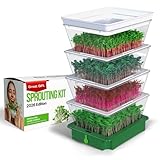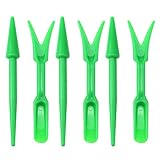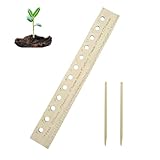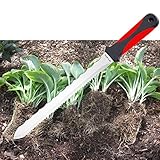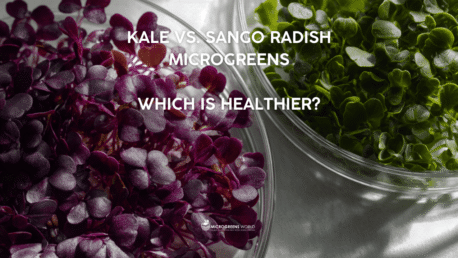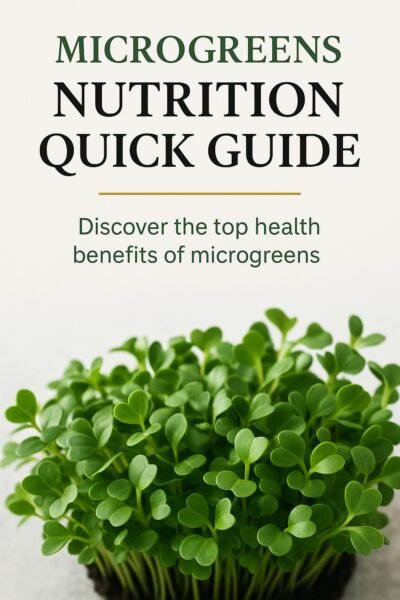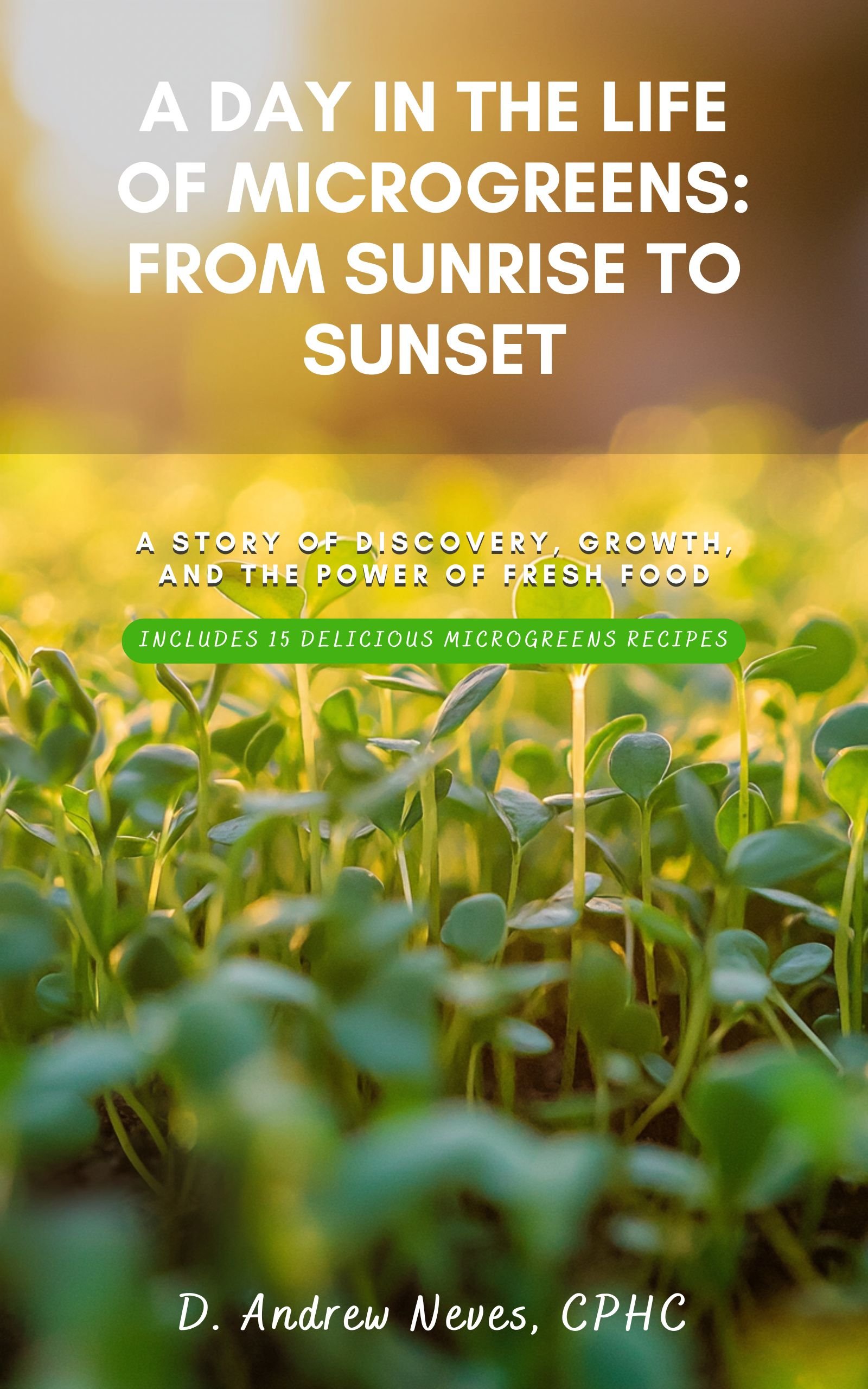Imagine unlocking the secret to a healthier, more vibrant lifestyle from your kitchen. It’s possible with the power of microgreens! Once a well-kept secret, microgreens have exploded onto the health scene, boasting over 3,000 scientific papers in the past eight years, attesting to their nutritional prowess.
Are you intrigued? You should be. These tiny greens are not just a culinary trend but a health revolution. Packed with vitamins, minerals, and antioxidants, they outshine their mature counterparts in nutritional value. But what microgreens to grow?
Radish, arugula, broccoli, sunflower, kale, beet, pea, spinach, and mustard microgreens are highly nutritious, containing essential vitamins A, B, C, E, K, minerals calcium, iron, magnesium, and potassium, sulforaphane, and antioxidants such as anthocyanins and quercetin, beta-carotene, and lutein.
But here’s the real kicker: these nine are among the most nutritious. This post will delve into the benefits of these nine super microgreens, giving you the knowledge to choose what to grow and consume.
So, whether you’re a health-conscious consumer, an urban dweller, a gourmet chef, a food enthusiast, or a parent, this article is a must-read. Click on the links to explore and join today’s microgreens revolution!”
Key Takeaways: The Most Nutritious Microgreens at a Glance
While many microgreens are nutrient-dense, scientific research and nutritional data show that certain varieties excel for specific health benefits. Here are the top performers from our list:
| Microgreen | Primary Nutritional Benefit | Best For |
| Broccoli | Sulforaphane Content | Cellular Health & Detoxification |
| Pea Shoots | Vitamins A, C, & Folic Acid | Immune Support & Overall Vitality |
| Radish | Vitamin E & Antioxidants | Skin Health & Fighting Free Radicals |
| Sunflower | Complete Protein & Zinc | Muscle Repair & Immune Function |
New Scientific Study Ranks the Top Nutritional Performers (2025 Update)
To provide a clear, data-driven answer on which microgreens are truly the healthiest, a 2025 study published in the peer-reviewed journal Antioxidants conducted a head-to-head analysis of 15 different microgreens from the Brassicaceae family (the group that includes kale, radishes, and cabbage).
The goal was to move beyond general knowledge and scientifically measure the specific nutritional and antioxidant power of each. The research identified two standout winners for specific health benefits: Kale and Sango Radish.
Key Findings from the Study:
-
For Eye Health & Minerals: Kale microgreens were the definitive winners. They contained the highest levels of carotenoids like Lutein and Beta-Carotene, which are critical for protecting vision. Kale also tested highest for essential minerals like calcium and potassium.
-
For Overall Antioxidant Power: Sango Radish microgreens ranked highest for their ability to fight free radicals and protect against cellular damage. Their deep purple color comes from powerful antioxidants that also showed potential for helping to manage blood sugar.
At a Glance: Kale vs. Sango Radish
| Feature | Kale Microgreens | Sango Radish Microgreens |
| Primary Benefit | Eye Health & Minerals | Overall Antioxidant Power |
| Key Compounds | Lutein, Beta-Carotene | Anthocyanins |
| Mineral Content | Very High (Ca, K) | Good |
| Antioxidant Score | Good | Excellent |
The full study provides an in-depth analysis of these findings and underscores that while many microgreens are healthy, choosing a specific variety like Kale or Sango Radish can provide targeted nutritional benefits.
INTERESTED IN MICROGREENS?
Join the community
Join more than 50,000 other health-conscious individuals and couples who visit our site and receive weekly emails from us to help them grow more microgreens to live healthier and longer lives.

Firstly, microgreens are an excellent source of nutrients. The nutrition varies among microgreens, but generally, they are excellent sources of nutrients. They are filled with nutrients such as copper, iron, phosphorus, zinc, potassium, calcium, and magnesium. Some studies have shown that microgreens contain more nutrients than their fully-grown counterparts. Incorporating microgreens into your diet can quickly help you meet your daily recommended intake of vitamins and minerals.
Another benefit of microgreens is that they are easy to grow and can be grown at home with minimal equipment. They can be grown in soil or hydroponically, meaning you can grow them in small spaces such as your kitchen or balcony. They are an affordable and accessible way to add fresh greens to your meals.
Each variety of microgreens has a unique flavor and scent. Some may be sweet, while others may be bitter. You can cook them up in any way you desire, and they’re versatile enough to use in just about any dish on your menu. You can experiment with combinations to find your favorite microgreen flavor.
Now, look at nine of the most nutritious microgreens that are easy to grow at home.
The Most Nutritious Microgreens
Regularly consuming microgreens may help protect your body from oxidative stress linked to several chronic diseases, including cancer, diabetes, and heart disease.
Radish Microgreens
Radish microgreens are a fast-growing and popular choice, prized for their spicy, peppery flavor and dense nutritional profile. You can harvest radish microgreens in as little as four days.
-
Key Nutrients: High in Vitamins C, E, and K, plus Vitamin A, B vitamins (like folate), calcium, potassium, iron, and antioxidants like glucosinolates.
-
Primary Health Benefits: Provides powerful antioxidant protection against cell damage, supports the immune system, possesses potential anti-cancer properties, and promotes heart and bone health.
Take a deeper dive into this superfood in my post, “Radish Microgreens: The Superfood Chefs and Health Enthusiasts Love.”
Arugula microgreens
Arugula microgreens are a fast-growing crop, celebrated for their peppery, spicy flavor and concentrated nutrient content. They take around 5-7 days to grow, and you can harvest them when they reach a height of 1-2 inches.
-
Key Nutrients: High levels of Vitamin K, Vitamin C, and Vitamin A, plus calcium, iron, potassium, and beneficial compounds like glucosinolates.
-
Primary Health Benefits: Supports bone and heart health, provides powerful antioxidant and anti-inflammatory properties, and aids in digestion and detoxification.
What I call the ‘Natural Viagra.’ Don’t believe me? Then check out my post, “Arugula Microgreens: A Delicious Way to Get Your Vitamins and Minerals.”
Broccoli microgreens
Broccoli microgreens are nutritional powerhouses, renowned for their mild flavor and for containing exceptionally high levels of the compound sulforaphane (Kim et al, 2016). They take around 5-7 days to harvest.
-
Key Nutrients: High in Sulforaphane, Vitamins A, C, E, and K, Folate, Fiber, and minerals like Calcium, Potassium, and Iron.
-
Primary Health Benefits: Offers potent anti-cancer and anti-inflammatory properties, supports the body’s natural detoxification processes, promotes cardiovascular and digestive health, and helps boost the immune system.
Discover the ‘King of the Microgreens’ in my post, “The Ultimate Guide to Broccoli Microgreens Nutrition including Nutrition Data, Facts, Info, and Recipes.”
Sunflower microgreens
Sunflower microgreens are a nutritional powerhouse, prized for their crunchy texture, nutty flavor, and status as a complete protein. They take about 7-10 days to grow and can be harvested when they reach a height of 1-2 inches.
-
Key Nutrients: A complete protein (containing all essential amino acids), high in Vitamins A, B complex, C, E, and K, and minerals like calcium, iron, potassium, and magnesium.
-
Primary Health Benefits: Supports the immune system, promotes heart and bone health, provides significant antioxidant and anti-inflammatory properties, and aids in healthy digestion.
The big plant that’s filled with energy. Explore the sunflower microgreens in my post, “Tiny Giants: Sunflower Microgreens and Their Incredible Healing Properties.”
Kale microgreens
With a mildly peppery and earthy flavor, kale microgreens are one of the most nutrient-dense foods available, packing a significant nutritional punch in a tiny package. Kale microgreens take 7-10 days to harvest.
-
Key Nutrients: Extremely high in Vitamin K and Vitamin C, rich in Vitamin A, calcium, iron, potassium, and powerful antioxidants like lutein, zeaxanthin, and polyphenols.
-
Primary Health Benefits: Greatly supports bone health and blood clotting, boosts the immune system, provides potent antioxidant and anti-cancer properties, and helps protect eye health.
The green powerhouse! Discover the nutritional power of kale in my post, “Unlocking the Nutritional Powerhouse: The Kale Microgreens Guide.”
Pea microgreens
Pea microgreens are a popular and easy-to-grow choice, celebrated for their sweet, crisp flavor and impressive nutritional profile. They take around 10-14 days to grow and can be harvested when they reach a height of 1-3 inches.
-
Key Nutrients: Exceptionally high in Vitamin C, also a great source of Vitamins A and K, iron, calcium, potassium, folate, and antioxidants like beta-carotene.
-
Primary Health Benefits: Strongly supports the immune system, promotes healthy skin and blood clotting, protects eye health, and provides powerful antioxidant protection against cell damage.
More vitamin C than an orange? You bet! Discover the nutritional power in my post, “The Potent Nutrients in Pea Microgreens: A Comprehensive Guide.”
Beet microgreens
With their vibrant red stems and a mildly sweet, earthy flavor, beet microgreens are a visually striking and nutrient-dense addition to any meal. Beet microgreens take around 10-14 days to grow and can be harvested when they reach a height of 1-3 inches.
-
Key Nutrients: High in Vitamins K, C, and A, rich in minerals like iron, magnesium, potassium, and calcium, and contain potent antioxidants, particularly betalains.
-
Primary Health Benefits: Provides powerful anti-inflammatory and detoxification support, promotes heart and bone health, boosts the immune system, and supports healthy vision.
A versatile root plant that I didn’t know had so many varieties. Explore the variety and “Discover the Nutritional Wonders of Beet Microgreens.”
Spinach microgreens
Known for their mild, tender leaves and a slightly sweet, earthy flavor, spinach microgreens are a nutritional powerhouse, containing significantly more concentrated nutrients than their mature counterparts. Spinach microgreens take around 10-14 days to grow and can be harvested when they reach a height of 1-3 inches.
-
Key Nutrients: Exceptionally high in Vitamins A, C, and K, along with vital minerals like iron, calcium, potassium, and folate. They are also a rich source of antioxidants, including beta-carotene, lutein, and zeaxanthin.
-
Primary Health Benefits: Supports robust immune function, promotes bone and heart health, protects vision from light-induced damage, and provides powerful antioxidant and anti-inflammatory properties to help reduce the risk of chronic diseases.
I grew up watching ‘Popeye the Sailor Man.’ The spokesman for spinach. Find out just how you can “Supercharge Your Health: Discover the Nutritional Magic of Spinach Microgreens.”
Mustard microgreens
With a distinctly spicy and peppery flavor, mustard microgreens are a zesty and nutrient-dense addition to any dish, offering a concentrated source of powerful plant compounds. Mustard greens microgreens take about 7-13 days to be harvested.
-
Key Nutrients: High in Vitamins A, C, E, and K, a good source of minerals like calcium, iron, and potassium, and rich in antioxidants such as glucosinolates and phenolic compounds.
-
Primary Health Benefits: Provides potent antioxidant and anti-inflammatory properties, supports the immune system, aids in detoxification, promotes heart and bone health, and may help inhibit the growth of cancer cells.
Want a delicious and nourishing microgreens snack? Try our “Mustard Microgreens and String Beans: A Perfect Pairing in the Kitchen“ recipe.
Growing microgreens at home is easy. Follow the following steps to grow microgreens in the comfort of your home:
| Step | Procedure |
|---|---|
| Select the right container | You can use any shallow container with drainage holes for growing microgreens, such as plastic trays, seedling flats, or even repurposed egg cartons. Make sure the container is clean and has adequate drainage. |
| Select the right growing medium. | Microgreens can be grown in soil or a soilless medium such as coconut coir or peat moss. Good quality potting soil works well too. Avoid using garden soil, as it may contain pests and diseases. |
| Select the right seeds. | Choose seeds that are specifically labeled for microgreens. Some popular microgreen seeds include broccoli, radish, pea shoot, sunflower, kale, arugula, cilantro, basil, and wheatgrass. Ensure the seeds are non-GMO and organic for the best quality and flavor. |
| Plant the seeds | Spread the seeds evenly over the soil and press them lightly into the soil. The seeds should be spaced about 1/4 inch apart. Cover the seeds with a thin layer of soil or vermiculite. |
| Water the Seeds | Water the seeds lightly with a spray bottle or watering can. Keep the soil moist but not waterlogged. The seeds should be kept in a warm and humid environment, such as under a dome or plastic wrap. |
| Provide adequate light and moisture. | Place the container in a well-lit area, such as a windowsill, with at least 6 hours of sunlight daily. Water the microgreens regularly, but be careful not to overwater them, as this can cause fungal growth and other problems. |
| Harvest the microgreens | Microgreens can be harvested when they reach a height of about 1-2 inches. Use a sharp pair of scissors or a knife to cut the microgreens just above the soil surface. Rinse the microgreens in cool water and pat them dry with a paper towel before using them in your meals. |

It’s best to start with the best seeds and growing kits to grow your microgreens. Microgreens can be grown indoors year-round with the right equipment, making it a great way to ensure a fresh supply of nutrient-rich greens.
Seeds
When it comes to microgreen seeds, there are many options available, including herbs, vegetables, and even edible flowers. However, we suggest you start with these nine. It’s essential to choose high-quality seeds specifically labeled for microgreen production.
Burpee Wild Arugula Selvatica (click to check price on Amazon). I love my Burpee seeds. These wild Arugula seeds are perfect if you’re starting. Easy and quick to grow.
These seeds are often sold in bulk and can be found online or at your local garden center. I have done most of the work for you here: ”Picking the Best Seeds to Grow Microgreen.”
Growing Kits
Microgreen growing kits come in various sizes and styles, depending on your needs. Some kits include everything you need to start, including seed trays, soil, and seeds. Other kits may include trays and soil, allowing you to choose your seeds.
The Verdeat gardening system, a modular, fully automatic gardening system, is ideal for growing microgreens on kitchen countertops. It is compact and beautifully designed for a small apartment or townhome. If you want to explore more, read “”
One popular type of microgreen growing kit is a hydroponic system, which allows you to grow microgreens without soil. These systems use water and nutrients to grow the plants and are often compact and easy to use.
Another option is to use a traditional seed tray with soil. These trays are typically made of plastic and can be reused multiple times. These growing containers are on Amazon.com. These efficient but straightforward planting pots are perfect for starting out growing microgreens. They look beautiful too on your windowsill.
You must fill the tray with a high-quality soil mix and sprinkle the seeds evenly. Your microgreens will sprout after a few days of watering and proper lighting.
Lighting
Microgreens require bright, direct light to grow properly. If you’re growing microgreens indoors, give them at least 12 hours of light daily. This can be achieved using grow lights, specifically designed to provide the spectrum of light plants need to grow. This LED grow light is on Amazon.com. Simple, elegant, efficient. This small full, spectrum grow light is ideal for indoor microgreens indoors. It brings photosynthesis when you don’t have the sun.
Harvesting
Once your microgreens have reached the desired height, it’s time to harvest them. Cut the microgreens just above the soil line using a sharp pair of scissors. Rinse the greens with water and then pat them dry before eating.
For all your tools to grow microgreens, head to “Best Microgreens Products: My Tried and Tested Picks.”

How to Cook and Eat Microgreens
If you are new to microgreens and wondering how to eat them, keep reading for tips and ideas.
As a Garnish
Microgreens can also be used as a garnish for many dishes, including soups, stews, and cocktails. Wash and dry the microgreens and place them on your dish as a final touch.
Blend them into smoothies.
Consider adding microgreens to take your smoothies to the next level. Not only do they add vibrant color and fresh flavor, but they also boost the nutritional value of your smoothie. Microgreens like spinach, kale, and wheatgrass are delicious in smoothies as they are high in vitamins and minerals.
Add them to salads
One of the easiest ways to incorporate microgreens into your diet is by adding them to salads. They add a fresh flavor and texture to any salad, and you can mix and match different varieties to create a colorful and nutrient-dense dish. Microgreens like arugula, kale, and radish are particularly good in salads, as they add a peppery kick and complement other ingredients well.
Top your sandwiches and wraps.
Another way to use microgreens is adding them to your sandwiches and wraps. They provide a refreshing, crispy layer that balances heavier ingredients like meat and cheese. Microgreens like alfalfa, broccoli, and sunflower are great options for sandwiches and wraps, as they are mild in flavor and pair well with various fillings.
Are you looking for more great microgreens recipes? Look no further. Try “ Eat Now! Microgreen Juices: 25 Savory Pocket Recipes (The Easy Guide to Microgreens Book 3) ”
Wrap-Up: The 9 Most Nutritious Microgreens.
Microgreens are a staple in any health-conscious person’s diet. They can be grown in a kitchen, garden, or apartment home. Not only do they boast more nutrients than their fully-grown counterparts, but they also make for a sweeter and milder taste than their larger counterparts. Even if you have an aversion to the taste of vegetables, microgreens should not be missed out on!
Microgreens are an excellent way to ensure you get your daily dose of vitamins, minerals, and other micronutrients, as they are an excellent source for those who may want to supplement their diet but don’t want to overeat food at once.
Frequently Asked Questions
What is the single most nutritious microgreen?
There is no single “most nutritious” microgreen because each variety offers a unique and powerful blend of vitamins, minerals, and antioxidants. For instance, broccoli microgreens are prized for their high sulforaphane content, while sunflower microgreens are a complete protein. The best strategy is to consume a wide variety of different microgreens to benefit from their diverse nutritional strengths.
Are microgreens healthier than regular vegetables?
Yes, microgreens are generally more nutrient-dense than their mature counterparts. Scientific studies have shown that microgreens contain significantly higher concentrations of vitamins, minerals, and antioxidants by weight (Xiao et al, 2012). While the exact levels vary by plant and nutrient, they are a highly efficient way to get a concentrated dose of plant-based nutrition, though mature vegetables still provide essential fiber.
Which microgreens are best for beginners to grow?
Pea shoots, radish, broccoli, and arugula microgreens are widely considered the best for beginners. They germinate quickly, grow reliably, and are typically ready to harvest in 7 to 10 days, making them a great and rewarding introduction to growing your own food.
Explore More About Microgreens
How do I grow microgreens indoors?
Growing microgreens indoors is not hard at all. You can get all the easy steps by reading the post “Beyond the Windowsill: Growing Microgreens on Your Balcony or Patio.”
How do I learn more about microgreens?
You should read my post, “The Beginner’s Nutritional Guide to Incredible Microgreens.” It covers much information about microgreens, their nutritional content, and why they are beneficial to a healthy diet.
Are microgreens considered a superfood?
Microgreens are considered a superfood because of their rich and dense nutritional qualities. Read more in the post, “Forty Times More: Microgreens, The Superfood of Superfoods.”
INTERESTED IN MICROGREENS?
Join the community
Join more than 50,000 other health-conscious individuals and couples who visit our site and receive weekly emails from us to help them grow more microgreens to live healthier and longer lives.
References
Xiao Z, Lester GE, Luo Y, Wang Q. Assessment of vitamin and carotenoid concentrations of emerging food products: edible microgreens. J Agric Food Chem. 2012;60(31):7644-7651.
Edel AL, Barretts A, Dibrov E, et al. Red cabbage microgreens lower circulating low-density lipoprotein (LDL), liver cholesterol, and inflammatory cytokines in mice fed a high-fat diet. J Agric Food Chem. 2014;62(44):11070-11078.
Gao L, Mazza G. Characterization, quantitation, and distribution of anthocyanins and colorless phenolics in sweet basil (Ocimum basilicum L.). Food Chem. 2012;132(1):179-188.
Valko M, Rhodes CJ, Moncol J, Izakovic M, Mazur M. Free radicals, metals and antioxidants in oxidative stress-induced cancer. Chem Biol Interact. 2006;160(1):1-40.
Burkitt DP. Epidemiology of large bowel disease: the role of fibre. Recent Results Cancer Res. 1979;67:169-177.
Kim, H. K., & Park, K. I. (2016). Sulforaphane enhances the anti-cancer activity of taxanes against triple negative breast cancer through the inhibition of tubulin polymerization. Biochemical and Biophysical Research Communications, 477(4), 509-514.
Kensler, T. W., Chen, J. G., Egner, P. A., et al. (2005). Effects of glucosinolate-rich broccoli sprouts on urinary levels of aflatoxin-DNA adducts and phenanthrene tetraols in a randomized clinical trial in He Zuo township, Qidong, People’s Republic of China. Cancer Epidemiology, Biomarkers & Prevention, 14(11 Pt 1), 2605-2613.
“What Are Microgreens and How to Grow Microgreens.” Gardening Know How, 23 July 2021, www.gardeningknowhow.com/edible/vegetables/lettuce/growing-microgreens.htm.
“How to Grow Microgreens.” HGTV, www.hgtv.com/outdoors/flowers-and-plants/vegetables/growing-microgreens. Accessed 23 June 2023.
“Step up Your Garden Game by Growing Microgreens Indoors.” Better Homes & Gardens, www.bhg.com/gardening/vegetable/vegetables/how-to-grow-microgreens-indoors/.































![[Comprehensive Microgreens Growing Kit] Our package includes 12 high-quality natural hemp fiber mats (10in × 10in) and 6 sturdy trays, offering more mats for greater convenience and value, enabling you to cultivate microgreens effortlessly at home. [...](https://m.media-amazon.com/images/I/514An8HpEwL._SL160_.jpg)

